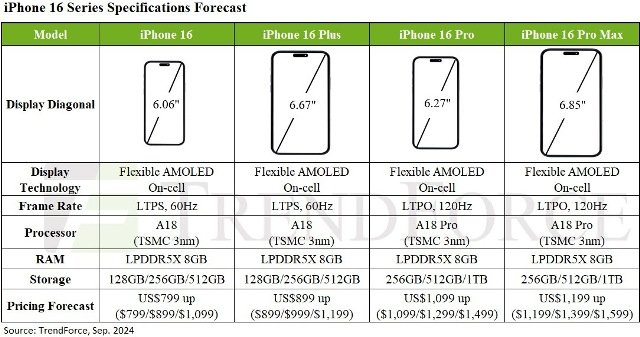Apple’s highly anticipated iPhone 16 series, set for release later this year, will be powered by the all-new A18 and A18 Pro processors and feature a significant DRAM upgrade to support Apple Intelligence. The new smartphone lineup marks a major leap in processing technology and AI integration, setting the stage for strong competition in the phone market.

Since the announcement of Apple Intelligence at WWDC24, excitement has been building.
Apple expects to ship 86.7 million units of its four new models in the second half of 2024, an 8 percent increase.
Industry analysts at TrendForce suggest this production surge could help Apple surpass Samsung by year-end, potentially securing its spot as the top smartphone manufacturer by market share for the first time ever.
Key to the iPhone 16’s performance are its A18 and A18 Pro processors, both produced using TSMC’s 3nm N3E process, ensuring high efficiency and lower production costs. For the first time, Apple is moving away from reusing the previous generation’s processor in some models. This uniformity could give the entire lineup a significant performance boost.
Apple iPhone 16 Pro models will feature slightly larger displays as compared with their predecessors. However, despite early rumors of a 90Hz refresh rate for the iPhone 16 and 16 Plus, they will maintain the 60Hz rate. On the other hand, all models will see an upgrade to LPDDR5X 8GB DRAM to support the AI-driven Apple Intelligence.
Apple Intelligence, though not as robust in terms of LLM (large language model) parameters compared to Android devices powered by Google, is expected to deliver superior integration due to Apple’s tight ecosystem and proprietary hardware. Siri’s accuracy will be improved through a partnership with ChatGPT maker OpenAI, and new features will gradually roll out across more languages.
Retail pricing for the iPhone 16 series is expected to be cautious. TrendForce notes that the base price may remain comparable to the iPhone 15 series, with only slight increases to accommodate higher memory costs. Notably, the iPhone 16 Pro, equipped with a periscope lens, could follow the Pro Max’s strategy by starting with 256GB of storage, offering more value to offset any price hikes.
Apple’s strategy of charging premiums for storage upgrades is likely to continue, driven by consumers’ growing needs for storage space in light of high-resolution photos, videos, and large apps. This trend, coupled with rising NAND Flash prices, could further bolster Apple’s profitability.
Despite the excitement surrounding Apple Intelligence, its future in China remains unclear, potentially impacting sales in that market. However, Apple’s continued focus on hardware and system integration should help sustain strong global demand for the iPhone 16 series.
Baburajan Kizhakedath
